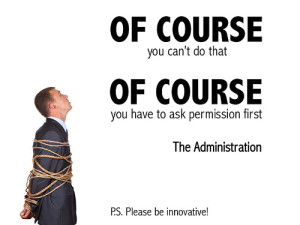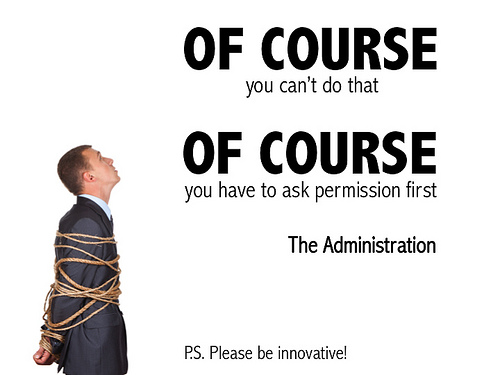
Photo Credit: Scott McLeod via Compfight cc
My clients complain about micromanaging bosses more than any other problem. Yet almost no one sees himself or herself as a micro-manager. And people have asked me what is so bad about micromanaging. Isn’t it a good thing to want something done right?
Micromanagers Hurt Staff – and Themselves
Micro-managers disempower, annoy and anger their staff. They send the message “I don’t trust you.” And they make it impossible for people to do their best work. People stop caring to do a good job because it will never be good enough for a micro-manager.
I’ve been micromanaged, and all it did was make me want to leave the job. It was so disheartening to be criticized about how I did something. What did it matter? Was it more important exactly how I did it, or that the thing got done well, on time, in scope, delivering desired impact? I felt my boss had really messed up priorities. And if my boss didn’t care very much about the impact or quality of the end product, why should I?
What the micro-manager doesn’t realize is that micro-managing hurts them, too. S/he is not able to be a leader as long as s/he micromanages. Micro-managers stay at a lower level of achievement.
Fear of losing control is the biggest reason most bosses micro-manage. Yet in my experience, they have already lost control – to the fear.
Micro-managers believe they will get the perfect product through controlling how staff work. That’s a delusion. Micro-managed staff never deliver great product. Great product comes from freedom to use your skills and expertise without fear of criticism.
I have micromanaged people. I’d hired a Director of Development to do the fundraising for our organization. Two weeks into the job, she came to tell me she was quitting. Shocked, I asked why. Her response: “You aren’t letting me do my job.” I knew enough about fundraising to think I was adding value by making suggestions to her about what she could do. She saw it as my not trusting her to do the job for which I hired her. And she was absolutely correct. I told her I would change and I did. Since we’d agreed on her goals, I began asking for updates at our weekly meeting, and celebrating the progress she and her team made. If she wanted my input, she’d ask. She did a fantastic job of raising millions of dollars. And I got to focus on developing program, creating a strategic plan, working with the Board, and marketing the organization to external stakeholders – places I was needed.
Leaders Lead, Not Micromanage
If you want to be a leader, you need to let go of micro-managing. Leaders delegate to others, they don’t micro-manage.
It’s not that details aren’t important. They are. It’s just that leaders see that details are in service of the larger goal. And the “what” and the “substance” matter more than the method by which the substance is produced. I suggest asking the question “how important is it?” when tempted to tell someone how to do something. Chances are it’s not that important.
If you have to get in the weeds, at least ask a question about how your staff person is doing something. Listen. Approve. Ask for rationale about a certain approach. Accept the answer. If there is something that you think could be improved, say “do you mind if I make a suggestion?” You are showing respect for the person, and also teaching them something. Being coached and developed is usually welcomed by an employee.
Leaders get satisfaction from coaching people to do their best, instead of micromanaging them so they do it “your way.” Your employees’ way is good enough if they get the agreed-on desired results. Of course, if someone is behaving in a way that is contrary to company values, then the “how” matters. Decide what matters and develop ways to track it and make decisions.
Leaders Focus on the Big Picture or the “What”
The best leaders focus on trends and outcomes because they are how you assess the performance of the company or unit, and devising strategy to achieve goals. First, identify goals or a desired future state. Then look at where you are – which means gathering a lot of information. Then devise strategies to reach those goals. And identify key performance indicators (KPIs) that show whether you are on track to reach your goals.
The leader’s role is to examine the overall picture, and work with staff to make adjustments in strategy if goals are not being reached or external circumstances change significantly.
Leaders use technology to help with managing performance toward goals. There are tons of Software as a Service (SaaS) companies that have built comprehensive software platforms to gather and centralize your company’s data – the smallest details – and then aggregate it for display in performance dashboards.
For example, if you want to know how much staff costs are over time, you can use software (like this HR software from Cascade HR) to get a report summarizing payroll data over time. How the data got into the software isn’t your concern as a leader at that point in time. At the outset of the software process, you will want to see the plan your staff develop to enter data and ensure its accuracy. By getting regular progress reports, you’ll know the stage of data entry.
If you don’t trust your staff to tell you the truth or to work to a plan, you need to overhaul your hiring practices. Or you need to do some self-examination to understand why you would hire people you can’t trust.
Until you as a leader learn not to sweat the “how” it’s done, you will not be able to see the strategic issues that true leaders recognize and address. You’re too much in the weeds to see the broad field. And the broad field is where leaders make decisions that lead to progress toward overall team and company goals.
The opinions expressed here are my own. I have been compensated for mentioning software that I have researched.


